California Polytechnic State University, San Luis Obispo
California Polytechnic State University, San Luis Obispo (California Polytechnic State University,[8] Cal Poly[Note 1][9] or Cal Poly San Luis Obispo,[8]) is a public university in San Luis Obispo County, located directly adjacent to the City of San Luis Obispo. It is the oldest of three polytechnics in the California State University system.
 | |
Former name | California Polytechnic School (1901–1947), California Polytechnic State College (1947–1972) |
|---|---|
| Motto | Discere Faciendo (Latin) |
Motto in English | Learn by Doing |
| Type | Public polytechnic university |
| Established | March 8, 1901 |
Parent institution | California State University |
Academic affiliations | Space-grant |
| Endowment | $287.3 million (2021)[1] |
| President | Jeffrey Armstrong |
| Provost | Cynthia Jackson-Elmoore[2] |
Academic staff | 1,396 (Fall 2020)[3] |
Administrative staff | 1,587 (Fall 2020)[4] |
| Students | 22,287 (Fall 2020)[5] |
| Undergraduates | 21,447 (Fall 2020)[5] |
| Postgraduates | 840 (Fall 2020)[5] |
| Location | San Luis Obispo County , , United States |
| Campus | Suburban, 9,678 acres (3,917 ha) total; 1,321 acres (535 ha) for the main campus; 155 acres (63 ha) for the campus core[6] |
| Colors | Poly green and mustang gold[7] |
| Nickname | Mustangs |
Sporting affiliations | NCAA Division I FCS – Big West |
| Mascots | Chase the Mustang, Musty the Mustang |
| Website | www |
 | |
The university is organized into six colleges offering 65 bachelor's and 39 master's degrees. Cal Poly San Luis Obispo primarily focuses on undergraduate education and as of fall 2020, Cal Poly had 21,447 undergraduate and 840 graduate students.[5] The academic focus is on combining technical and professional curriculums with the arts and humanities. Most of the university's athletic teams participate in the Big West Conference. Cal Poly is eligible to be designated as an Asian American Native American Pacific Islander serving institution (AANAPISI).
History

Cal Poly San Luis Obispo was established as the California Polytechnic School in 1901 when Governor Henry T. Gage signed the California Polytechnic School Bill after a campaign by a journalist Myron Angel. The polytechnic school held its first classes on October 1, 1903, to 20 students, offering secondary level courses of study, which took three years to complete.[10] The school continued to grow steadily, except during a period from the mid-1910s to the early 1920s when World War I led to drops in enrollment and drastic budget cuts forced fewer class offerings.
In 1924, Cal Poly San Luis Obispo was placed under the control of the California State Board of Education. At the height of the Great Depression, the cash-strapped state government discussed the prospect of converting Cal Poly into a state prison.[11] In 1933, the Board of Education changed Cal Poly San Luis Obispo into a two-year technical and vocational school. The institution began to offer Bachelor of Arts degrees in 1940, with the first baccalaureate exercises held in 1942. The school was renamed the California State Polytechnic College in 1947 to better reflect its higher education offerings, and in 1949, a Master of Arts degree in education was added. In 1954, long after deciding to not turn Cal Poly into a state prison, the state government finally opened that prison at a separate site one mile (1.6 km) northwest of Cal Poly's campus. In 1960, control of Cal Poly San Luis Obispo and all other state colleges was transferred from the State Board of Education to an independent Board of Trustees, which later became the California State University system.[12]
The college was authorized to offer Master of Science degrees in 1967, and from then to 1970, the school's curriculum was reorganized into different units, such as the School of Science and Math, the School of Agriculture and Natural Resources, and the School of Architecture. Cal Poly San Luis Obispo's FM radio station, KCPR, began as a senior project in 1968. The California State Legislature changed the school's official name again in 1971 to California Polytechnic State University, and since the 1970s the university has seen steady enrollment growth and building construction.
Cal Poly San Luis Obispo celebrated its centennial in 2001 and kicked off a $225 million fundraising campaign, the largest fund-raising effort undertaken in CSU history. The Centennial Campaign raised over $264 million from over 81,000 donors, more than tripling the university's endowment from $43 million to over $140 million.
On May 3, 2017, Cal Poly received one of the largest gifts towards public education to be received in California from Cal Poly alumnus William L. and Linda Frost in the amount of $110 million.[13]
Relationship with Cal Poly Pomona
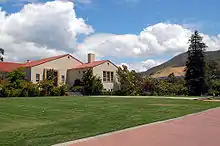
Cal Poly Pomona began as a satellite campus of Cal Poly San Luis Obispo in 1938 when a completely equipped school and farm were donated by Charles Voorhis and his son Jerry Voorhis of Pasadena, California, and was initially called the Voorhis Unit. The W.K. Kellogg Foundation then donated an 812-acre (329 ha) horse ranch in Pomona, California to Cal Poly San Luis Obispo in 1949. Located about one mile (1.6 km) from the Voorhis campus, the two became known as Cal Poly Kellogg-Voorhis. Cal Poly Kellogg-Voorhis broke off from Cal Poly in 1966, becoming the fully independent university, California State Polytechnic University, Pomona (Cal Poly Pomona). Since 1949, the two campuses have cooperated on creating a float for the Rose Parade. Today, the long-running float program still boasts floats designed and constructed entirely by students year-round on both campuses.
1960 football team plane crash
On October 29, 1960, a chartered plane carrying the Cal Poly San Luis Obispo football team, hours after a loss to Bowling Green State University, crashed on takeoff at the Toledo Express Airport in Toledo, Ohio. Twenty-two of the 48 people on board were killed, including 16 players.
Female admissions
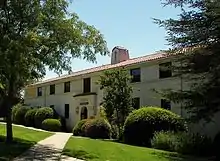
In 1903, Cal Poly San Luis Obispo opened as a coeducational school with 20 students enrolled, 16 new male students and 4 new female students.[15] In 1929, California Governor C. C. Young banned women from studying at Cal Poly San Luis Obispo starting from 1930. It wasn't until 1956 when the institution once again began admitting female students.[16] The university remains coeducational today, with women constituting 48.4% of the Fall 2018 total student population.[17]
Name
The school is typically referred to as "Cal Poly", or simply "Poly". The university's style guide indicates its official names are "California Polytechnic State University" and "Cal Poly."[18] When necessary to distinguish between Cal Poly and its former satellite campus, Cal Poly Pomona, the lengthier "Cal Poly at San Luis Obispo" is occasionally used. The California State University system's style guide identifies the university as "California Polytechnic State University, San Luis Obispo" and the elided "Cal Poly San Luis Obispo."[19] Although Cal Poly San Luis Obispo is part of the California State University, its naming convention does not follow that of most campuses within the system (for example, the CSU campus in San Diego bears the full official name "San Diego State University" and the CSU campus in Fullerton uses the name "California State University, Fullerton").[20][21] Thus, "San Luis Obispo State University" or "California State University, San Luis Obispo" are seldom used.
Directors and presidents
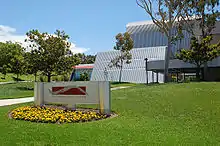
- Leroy Anderson, 1902–1907
- Leroy Burns Smith, 1908–1914
- Robert Weir Ryder, 1914–1921
- Nicholas Ricciardi, 1921–1924
- Margaret Chase (Acting), 1924
- Benjamin Ray Crandall, 1924–1933
- Julian A. McPhee, 1933–1966
- Dale W. Andrews (acting), 1966–1967
- Robert E. Kennedy, 1967–1979
- Warren J. Baker, 1979–2010
- Robert Glidden (Acting), 2010–2011
- Jeffrey D. Armstrong, 2011–present
Campus
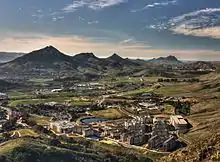
Cal Poly has one of the largest college campuses in the United States.[23] It owns 9,178 acres and is the second largest land-holding university in California.[6] The lands are used for student education and include the main campus, two nearby agricultural lands, and two properties in Santa Cruz County. Part of the Cal Poly property is the Swanton Pacific Ranch, a 3,200-acre (1,300 ha) ranch located in Santa Cruz County, California, outside the town of Davenport. The ranch provides educational and research opportunities, encompasses rangeland, livestock, and forestry operations for the College of Agriculture, Food, and Environmental sciences, and fosters Cal Poly's Learn by Doing teaching philosophy of with emphasis on sustainable management of agricultural practices with a mix of laboratory experiments.
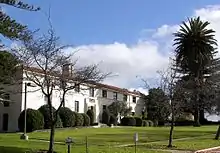
Expansion

The Cal Poly Master Plan calls to increase student population from approximately 17,000 students to 20,900 students by 2020–2021.[24] To maintain the university's Learn by Doing philosophy and low class sizes, the master plan calls for an increase in classrooms, laboratories, and professors.
Recent construction
A dormitory style student community was completed in the summer of 2018. Located at the corner of Slack Street and Grand Avenue, it consists of seven 3- to 5-story concrete framed freshman residence hall buildings with 1,475 beds and an adjacent four-level parking structure. Additional community space for the housing complex and the campus wrap the parking structure on three sides. These spaces include a small café, community room, game room, mail room, welcome center, offices, and maintenance shop. Site improvements include a large open space in the center of the project for activities and group events, volleyball and basketball courts, and outdoor gathering spaces at each building.[25]
The Warren J. Baker Center for Science and Mathematics was dedicated November 1, 2013.[26] It replaced the aging "spider" Science Building 52, built in the 1950s, with a new 189,000-square-foot (17,600 m2) structure. The $119 million, six-story building was made possible by voter-approved state education bonds and $18 million in private donations.[27] The Center adds new laboratories, classrooms, and offices for the physics, chemistry and soil science programs, as well as an open area and terraces for student study and meeting places. The top floor of the Center houses labs and offices for the school's Western Coatings Technologies Center and the Environmental Biotechnology Institute. It is the second largest and most technologically advanced structure on campus. In the space between the remaining wings of the old "Spider Building" and the new Center is Centennial Park, a landscaped central green.
Current and planned construction
A $20 million wine and viticulture center is projected to open in 2020.[28] The new $123 million Science and Agriculture Teaching and Research Complex is scheduled to open fall 2021; a renovation of The Robert E. Kennedy Library is expected to begin no sooner than January 2022 and cost $65 million.[29] In addition, the William and Linda Frost Center for Research and Innovation, a $124 million interdisciplinary research center, broke ground in May 2019.[30]
Commuting
Campus parking is limited. In its most recent survey of available parking spaces on campus, the Cal Poly University Police reported 2,892 general purpose parking spaces, 3,492 dorm resident spaces, and 8,648 total spaces.[31] In its facilities Master Plan, the university admits that while more parking spots will be added, the actual ratio of parking to students will decrease since enrollment is expected to increase sharply.[32] To resolve the disparity, the Master Plan calls on the university to reduce the demand for individual vehicle parking. As part of that plan, the university has constructed additional dorms and has tried to make campus life more desirable. In addition, Cal Poly Commuter and Access Services has successfully promoted alternatives to commuting in single occupancy vehicles: in the past 10 years, bus use has more than doubled, and the use of bicycles has close to quadrupled.[33]
Currently, there are over 6,500 bike rack spaces and 224 secure bike lockers available on campus; 57% of students and 33% of faculty/staff live within 5 miles of the Cal Poly campus, an easy bike commute.[34] The city's SLO Transit bus system provides service to and from campus. Cal Poly financially supports SLO Transit with funding from parking citation revenue (not from state general funds nor from student tuition), so faculty, staff, and students ride for free.[34] Bus service throughout the county is provided by SLO Regional Transit Authority. Discounted passes are available to the Cal Poly community.
Academics
Colleges
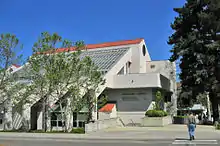
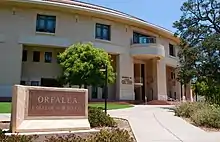
The university currently offers 65 bachelor's degrees, 39 master's degrees, 84 minors and 13 credentials in six colleges:[6]
- College of Agriculture, Food and Environmental Sciences
- College of Architecture and Environmental Design
- Orfalea College of Business
- College of Engineering
- College of Liberal Arts
- College of Science and Mathematics
Bachelor's projects
All undergraduate students at Cal Poly are required to complete a senior project. This requirement has been in place since the 1980s, and has set Cal Poly apart from other Cal State campuses. The senior project is intended to be a capstone experience for students receiving a baccalaureate degree by integrating theory and application from across a student's undergraduate educational experiences.[35] The senior project consists of one or more of the following: a design or construction experience, an experiment, a self-guided study or research project, a presentation, a report based on an internship, co-op, or service learning experience, and/or a public portfolio display or performance.[36] Senior projects have often led to students obtaining jobs or recognition for their work. In July 2011, a company created from a Senior Project, Punchd, was acquired by Google.[37] Jamba Juice, founded as "Juice Club", was inspired by the Senior Project idea but was founded after the founders had graduated.[38] On campus towards Poly Canyon, a popular area known as 'Architecture Graveyard' has many architecture Senior Projects, including experimental structures and unconventional architecture.
Admissions
Enrolled Fall Freshman Statistics[39][40]
| 2018 | 2017 | 2016 | 2015 | 2014 | 2013 | |
|---|---|---|---|---|---|---|
| Applicants | 54,663 | 48,588 | 48,162 | 46,820 | 43,812 | 40,402 |
| Admits | 16,491 | 16,817 | 14,202 | 14,651 | 13,533 | 13,953 |
| % Admitted | 30.2 | 34.6 | 29.5 | 31.3 | 30.9 | 34.5 |
| Enrolled | 4,398 | 5,253 | 4,341 | 4,943 | 4,662 | 4,871 |
| GPA | 4.00 | 3.95 | 3.92 | 3.92 | 3.88 | 3.87 |
| Avg. ACT Composite | 28.9 | 28.3 | 28.4 | 28.0 | 27.5 | 27.3 |
| Avg. SAT Composite* | 1329 | 1293 | 1251 | 1239 | 1234 | 1232 |
| * SAT out of 1600 |
Cal Poly's admissions process is "more selective" according to U.S. News & World Report.[41]
For the class entering Fall 2019, 15,366 freshmen were accepted out of 54,072 applicants, a 28.4% acceptance rate, and 4,613 enrolled. Fall 2019 entering students had an average GPA of 3.99; the middle 50% range of SAT scores was 620–700 for reading and writing, and 620–740 for math, while the ACT Composite range was 26–32.[42] Women constituted 50.5% of the incoming freshmen class, men 49.5%.[42]
For Fall 2019 admitted transfer students, Cal Poly accepted 1,622 of 11,109 applicants, a 14.6% acceptance rate.[43]
Cal Poly requires students to declare a major when applying for admission, and the university then admits the most competitive applicants within each major based on GPA and SAT or ACT scores. As a result, changing majors at the university is not guaranteed. Each major has a specific change of major plan which includes required classes to be taken while maintaining a certain GPA (usually between 2.5 and 2.75) in order to be considered as a candidate. In some cases, students wishing to change majors transfer to other universities.
Rankings
| Academic rankings | |
|---|---|
| Regional | |
| U.S. News & World Report[44] | 2 |
| Master's university | |
| Washington Monthly[45] | 26 |
| National | |
| Forbes[46] | 115 |
| THE / WSJ[47] | 201 |
| Global | |
| U.S. News & World Report[48] | 925 |
According to U.S. News & World Report's 2023 "Best Regional Universities West Rankings," Cal Poly is ranked second overall in the western United States out of 127 regional schools whose highest degree is a Master's, first in "Top Public Schools", first in "Best Colleges for Veterans", first in "Most Innovative Schools", 2 for "Best Undergraduate Teaching", 18 best value school, 46 in Undergraduate Research/Creative Projects and tied for 97th in "Top Performers on Social Mobility."[49] The same report ranked the College of Engineering seventh out of 220 public and private undergraduate engineering schools in the U.S. where doctorates are not offered[50] with national program rankings of:[49]
- Civil Engineering: first
- Computer Engineering: first
- Mechanical Engineering: second
- Electrical Engineering: second
- Aerospace Engineering: second
According to U.S. News & World Report's 2022 "Best Regional Universities West Rankings," Cal Poly is ranked second overall in the western United States out of 127 regional schools whose highest degree is a Master's, first in "Top Public Schools", first in "Best Colleges for Veterans", first in "Most Innovative Schools", third for "Best Undergraduate Teaching", 32 best value school, 46 in Undergraduate Research/Creative Projects and tied for 94th in "Top Performers on Social Mobility."[49] The same report ranked the College of Engineering seventh out of 220 public and private undergraduate engineering schools in the U.S. where doctorates are not offered[50] with national program rankings of:[49]
- Civil Engineering: second
- Electrical Engineering: second
- Computer Engineering: second
- Mechanical Engineering: second
According to U.S. News & World Report's 2021 "Best Regional Universities West Rankings," Cal Poly is ranked 3rd overall in the western United States out of 127 regional schools whose highest degree is a Master's, first in "Top Public Schools", first in "Best Colleges for Veterans", tied for first in "Most Innovative Schools", second for "Best Undergraduate Teaching", and tied for 96th in "Top Performers on Social Mobility".[49] The same report ranked the College of Engineering eighth out of 220 public and private undergraduate engineering schools in the U.S. where doctorates are not offered[50] with national program rankings of:[49]
- Industrial Engineering/Manufacturing: first
- Civil Engineering: second
- Electrical Engineering: second
- Computer Engineering: second
- Aerospace Engineering: second
- Mechanical Engineering: third
- Biomedical Engineering: third
Washington Monthly ranked Cal Poly 26th out of 614 schools in the U.S. "National Universities - Masters" category in 2020 based on its contribution to the public good in three broad categories: social mobility, research, and service.
Money magazine ranked Cal Poly 51st in the country out of 739 schools evaluated for its 2020 "Best Colleges for Your Money" edition[51] and 33rd in its list of the 50 best public schools in the U.S.[52]
Cal Poly ranked 40th in the U.S. for in-state students in PayScale's 2019 "Best Value Colleges", which ranked 2,006 colleges and universities for return on investment (ROI). According to PayScale's projections, Cal Poly has a 20-year net return on investment of $716,000. This ROI is the 2nd highest in the California State University system and is higher than all of the University of California schools except UC Berkeley.[53]
In 2019, Forbes magazine rated Cal Poly No. 115 out of the 650 best private and public colleges, universities and service academies in America. In 2008, the first year of the list, Cal Poly was ranked No. 369 out of 569.[54]
For 2019, Kiplinger ranked Cal Poly 19th out of the top 174 best-value public colleges and universities in the nation, and 3rd in California.[55]
In the 2019 edition of "America's Best Architecture & Design Schools" published by the architecture and design journal DesignIntelligence, Cal Poly was ranked the No. 3 most admired undergraduate architecture program in the nation.[56] The landscape architecture program was ranked 6th most admired in the country and 1st in the Western region.[57]
Cal Poly's Orfalea College of Business was ranked 59th among U.S. undergraduate business colleges in Bloomberg Businessweek's 2016 list (the latest).[58]
Financial
Tuition
Due to continued reductions in state funding, Fall 2011 fees for the average student reached approximately $2,600 per quarter.[59] For comparison, the Spring 2002 fees for the average student were $760 per quarter. While total yearly fees for an in-state student were just $2,976 in 2002, students entering in fall 2011 faced an annual fee of over $7,900.[60]
Of the students enrolled in fall 2014, 61.6% of undergraduates and 70.0% of first-time freshmen received some form of financial aid in 2014–15.[61] The amount of financial aid awarded in 2014–15 totaled $151.5 million, of which 64.3% came from federal funds, 11.9% came from state funds and 17.5% came from institutional funds.[61] Loans comprised 55.6% of the financial aid, 31.2% came in the form of grants, and 10.2% in scholarships.[61]
Endowment
Cal Poly's endowment more than tripled during its Centennial Campaign from $43.1 million to $140.1 million. Growth is attributed to gifts and prudent stewardship. However, since 2007, the university's endowment has fluctuated dramatically, going from $181.7 million in 2007[62] to $130.9 million in 2009,[63] before rebounding to $227.7 million in 2019, the 301st largest of 785 colleges and universities in the United States and Canada.[1]
Student life
Residence halls
Cal Poly's on-campus student housing of 6,239 spaces[64] is the largest student housing program in the California State University system.[65] Cal Poly housed 35.9% of fall 2015 undergraduates in 28 dorms on campus, and 98.7% of first-time freshmen lived on campus. In addition, 28.7% of Cal Poly sophomores lived on campus in fall 2015.[61]
There are five distinct groups of residence halls on the Cal Poly campus. The five North Mountain halls, constructed in the 1950s, are the oldest on campus still used for residential purposes.[66] The six "red-brick" halls were completed shortly afterward in 1959.[67] The Sierra Madre and Yosemite halls were finished by 1968, and the Cerro Vista Apartments were completed in 2003. The Poly Canyon Village housing complex, with a similar style as the Cerro Vista apartments, was completed in 2009 at a cost of $300 million, making it the California State University system's largest construction project to date.[68] In 2018, Cal Poly opened the seven-building complex yakʔitʸutʸu dorms on the site of the old Grand Avenue surface parking lot.[69] In addition to being state-of-the-art living spaces, the yakʔitʸutʸu residence halls serve to honor the heritage and culture of the Indigenous People of San Luis Obispo County, the yak titʸu titʸu yak tiłhini, Northern Chumash tribe.
Each of the residence halls represent a different living community on campus. The six red-brick halls are the Living-Learning Program halls for the different colleges of Cal Poly. The five North Mountain halls are organizationally a part of the engineering Living-Learning Program. The Sierra Madre and Yosemite halls are the First-Year Connection Program halls and focus on freshman-oriented transition programs. All buildings house students of all majors. The Cerro Vista Apartments is the Transitions community for first-year and second-year students. Poly Canyon Village is the Sophomore Success Program community, which is open to primarily to sophomores, but also juniors and seniors, and helps students transition into independent living.
Greek life
| Fraternities (NIC)[70] | Sororities (NPC)[71] | Fraternities & Sororities (USFC)[72] | |||
|---|---|---|---|---|---|
|
|
|
|
|
|
Greek organizations have been at Cal Poly since 1949. The Greek community consists of three governing councils at Cal Poly: United Sorority and Fraternity Council (USFC), Interfraternity Council (IFC), and Panhellenic Association (PHA). Cal Poly also offers Greek organizations based on academic fields of study.[73]
Week of Welcome orientation program
The Week of Welcome program, more commonly known as "WOW", serves as a volunteer-based orientation program for new students during the first week after move-in during the beginning of the school year in September. Its purpose is to introduce students to the campus and the community and prepare them for a successful college career. Freshmen are placed in a group with 10–12 other new students while transfer students are in groups of 40–60; each group is led by two current Cal Poly student orientation leaders. The "WOW" groups participate in an array of orientation events in addition to activities both on and off campus. In 2010, the awareness section of the program won the 2010 National Orientation Directors Association (NODAC) Media & Publications Showcase Award in the Emerging Technologies. The awareness section was entirely developed by student volunteers. The program started in 1956 and is now the largest volunteer orientation program in the nation.[74]
Cal Poly Recreation Center
.jpg.webp)
The Cal Poly Recreation Center is the on-campus student recreation center.[75]
Clubs and independent student organizations
Cal Poly has many recognized clubs and independent student organizations operating on campus. Included (a full list available on the Associated Students, Incorporated website) are over 150 groups, including, among many others, cultural clubs and exchanges, mathematics and science clubs, improv and sketch comedy clubs, religious and atheistic groups, service organizations, engineering research and development clubs, professional development organizations, a perennial Rose Parade Float design program, LGBTQ+ and Multicultural groups, competitive and social athletic teams, and academic honors clubs. Especially impressive are the engineering clubs and independent student organizations on campus such as Prove Lab, PolySat, CubeSat, and QL+.[76]
Racial and economic diversity of student body
| Race and ethnicity[77] | Total | ||
|---|---|---|---|
| White | 54% | ||
| Hispanic | 18% | ||
| Asian | 13% | ||
| Other[lower-alpha 1] | 12% | ||
| Foreign national | 2% | ||
| Black | 1% | ||
| Economic diversity | |||
| Low-income[lower-alpha 2] | 14% | ||
| Affluent[lower-alpha 3] | 86% | ||
As of 2018, Cal Poly San Luis Obispo has the least racially diverse student population of all California State University and University of California campuses.[78] On a national scale, however, Cal Poly is ranked 240 out of 2,475 colleges and is considered "highly diverse" by collegefactual.com.[79] President Armstrong has been working to increase the percentage of non-white students on campus, with the share of white students in the university student body decreasing from 63% to 55%.[80] The City of San Luis Obispo is 84.5% white.[81] About 84.2% of the students attending California Polytechnic State University - San Luis Obispo come from within California.[82]
The Los Angeles Times reported that the university "was ranked one of the nation’s worst serving institutions for Latino student success."[83][84]
The Education Trust lists the university as an "Engine of Inequality" because "very few students come from working-class and low-income families." It's one among 20 public institutions in the U.S. with this negative distinction.[85]
Relations with local community
Though generally regarded as a positive for the area due to the economic impact, Cal Poly has received criticism for both the behavior of students upsetting the community, and the effects on local housing market. Parties and gatherings have gotten wilder due to an increased student body size and social media presence, leading to the university being named the #9 party school in California by Niche.[86] In 2017, the median home price in San Luis Obispo was $530,000.[87] In May 2018, Zillow estimated that the median home value has increased to $694,027.[88] While the city has been building hundreds of single family housing on the south end of town, large areas of the north end in older neighborhoods have been converted to rental student housing because of a major increase in the number of students admitted to and attending the university and the lack of university supplied housing. The university is currently building housing on campus to attempt to house up to 65% of students and plans to cap enrollment at 25,000, meaning that 11,250 students must find off-campus housing.[89] This has created an affordability crisis for the city itself, as most apartments that would generally be occupied by lower income families and individuals are now occupied solely by Cal Poly students, reducing supply and pushing low-income residents outside of the city. Approximately 27% of the residents live below the poverty line, a similar percentage to Cleveland, Ohio.
Athletics
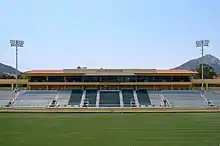
Cal Poly fields 21 varsity sports (10 for men and 11 for women)[90] and participates in the NCAA's Division I.
Cal Poly is a member of the Big West Conference, except for football, wrestling, women's indoor track & field and both swimming and diving teams (none of which are sponsored by the Big West). Cal Poly's football team competes in the Big Sky Conference; the wrestling team is a member of the Pac-12 Conference; indoor track & field is independent; and swimming and diving competes in the Mountain Pacific Sports Federation.
Prior to joining Division I in 1994, the school won 35 NCAA Division II national team championships[91] and competed in the California Collegiate Athletic Association (CCAA). Cal Poly has two mascots. The character represented in costume or cartoon is named Musty the Mustang. The live mascot, a living mustang, is named Chase, after Margaret Chase, the university's second president.[92]
Cal Poly also offers various non-varsity (club) sports. The Mustangs play college rugby in the California Conference of Division 1-A. The Mustangs are often ranked in the Top 25 nationwide,[93] and their rugby sevens team has been ranked as high as No. 7.[94] The Mustangs finished No. 8 in the nation at the 2011 USA Rugby Sevens Collegiate National Championships, and 12th at the 2012 competition.[95]
The Battle for the Golden Horseshoe is an annual rivalry college football game played between the UC Davis Aggies and the Cal Poly Mustangs.[96] Cal Poly has The Mustang Marching Band of over 200 students who play at football, basketball and volleyball games.
Incidents and controversies
Poly Royal Riots
On April 29, 1990, San Luis Obispo police responded to a call of a bicyclist down at around 11pm. The activity drew heavily intoxicated crowds that began to get unruly. After unsuccessfully attempting to disperse the crowd, a mob began looting the nearby Campus Bottle Shoppe. The next day, dumpsters were set on fire during more rioting and 127 people were arrested.[97]
Disappearance of Kristin Smart
On May 25, 1996, Cal Poly student Kristin Smart disappeared without a trace after a birthday party. The university and sheriff's department have been investigating leads, including excavating the land around the Cal Poly "P" on an adjoining hill. In 2017, the excavation of the area surrounding has been completed with articles found, however the sheriff's department has not yet released what the findings are. On April 13, 2021, Paul Flores and his father, Ruben Flores, were arrested and taken into custody in suspicion of Smart's disappearance. Their homes were searched, and investigators found numerous "items of interest".[98][99]
On October 18, 2022, a jury found Paul Flores guilty of murder, and his father, Ruben Flores, not guilty.[100]
Crops House incident
In 2008, a university-owned house (known as Crops House) where agriculture students were given subsidized lodging in exchange for work on the school's farms hosted a Halloween party with decorations including a noose. A sign was also posted which read: “No niggers,” along with a similar slur against gays. At a later date, the house displayed a Confederate flag tacked above the entrance to the house while a large Confederate flag laid painted on a table in front of the house.[101] This became a First Amendment free speech issue, with the university initially not evicting the students.[102]
Blackface incident
In 2018, the Lambda Chi Alpha fraternity was suspended following a photo surfacing that showed a student wearing blackface.[103] In response to further protests, President Armstrong suspended all Greek Life on campus indefinitely.[80] This was followed with protests during Open House events for incoming freshmen. On May 4, 2018, President Armstrong announced yet another blackface incident that was mocking the prior incident. The incident is being investigated by the state.[104]
Administrative organization
Four administrative divisions
The university is organized administratively into four divisions: Academic Affairs, Student Affairs, Administration and Finance, and University Advancement. The academic division is organized into six colleges, each with its own dean. Academic Affairs also includes the Library, Research and Graduate Programs, and Information Technology Services.
Cal Poly Corporation
The Cal Poly Corporation is a public-benefit, nonprofit corporation and university auxiliary. It provides commercial services, fiscal services, and key support services to assist and promote the educational mission of Cal Poly and the California State University System (CSU).[105] The Corporation engages only in those activities ancillary to state operation that are requested by Cal Poly's president and approved by the CSU. The corporation was founded in 1940 and was known as the Cal Poly Foundation until February 1, 2006.
Cal Poly Foundation
The Cal Poly Foundation is an auxiliary organization and IRC 501(c)(3) public charity that accepts and administers tax deductible gifts to the university. The Cal Poly Foundation leads campus philanthropic activity by supporting fundraising activities and investing and managing the campus endowments.[106]
Cal Poly Extended Education
The Cal Poly Extended Education provides access to degree, certificate, and professional development programs and services of the university to the citizens of San Luis Obispo, Santa Barbara, and Monterey Counties and through distance learning technologies to students across the country.[107]
Associated Students Inc.
The Associated Students Inc. (ASI) is a 501(c)(3) nonprofit corporation owned and operated by Cal Poly student leaders. ASI has an annual operating budget in excess of $12 million. ASI provides co-curricular experiences for students, faculty, and staff, including events, speakers, concerts, intramural sports, fitness programs, aquatics, outdoor adventure trips, craft center enrichment courses, club services, and child development.[108] ASI manages the University Union, Recreation Center, Sports Complex, and Children's Center, totaling more than 450,000 square feet (42,000 m2) of campus facilities.
Alumni Association
The Cal Poly Alumni Association seeks to engage and serve alumni, to foster a lifelong connection between the university and its alumni, and to foster goodwill and support for the university. The association includes 15 regional and special interest chapters.[109]
Notable alumni
Cal Poly has more than 150,000 alumni with the majority located in San Luis Obispo, Santa Clara and Los Angeles counties.[110]
 Robert L. Gibson
Robert L. Gibson Abel Maldonado
Abel Maldonado
 Doug LaMalfa
Doug LaMalfa Farzad Nazem
Farzad Nazem Devin Nunes
Devin Nunes
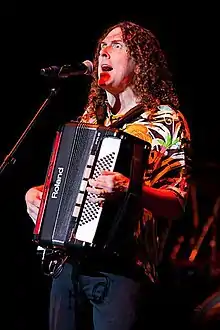
Notable Alumni include:
- Richard Bergquist, founder of PeopleSoft
- Tory Bruno, CEO of ULA
- Gregory Chamitoff, NASA Astronaut[111]
- Danding Cojuangco, former chairman and CEO of San Miguel Corporation[112]
- Robert “Hoot” Gibson, NASA Astronaut[111]
- Victor Glover, NASA Astronaut[113]
- Noel Lee, founder of Monster Cable
- Abel Maldonado, Former California Lt. Governor
- John Madden, NFL Hall of Fame coach
- Farzad Nazem, Chief Technology Officer of Yahoo
- Devin Nunes, U.S. Representative
- David Nwaba, shooting guard for the Houston Rockets
- Peter Oppenheimer, Former Chief Financial Officer of Apple Inc.
- Burt Rutan, aerospace pioneer
- Ozzie Smith, Baseball Hall of Fame Major League Baseball player
- Rick Sturckow, NASA Astronaut[111]
- William Swanson, former CEO of Raytheon
- "Weird Al" Yankovic, comedic musician who recorded his first song in a bathroom at the school
Demographics
California Polytechnic State University | |
|---|---|
| Country | United States |
| State | California |
| County | Santa Barbara |
| Population (2020) | |
| • Total | 8,583 |
| Time zone | UTC-8 (Pacific) |
| • Summer (DST) | UTC-7 (PDT) |
The United States Census Bureau has designated the campus as a separate census-designated place (CDP) for statistical purposes, under the name California Polytechnic State University. It first appeared as a CDP in the 2020 Census with a population of 8,583.[114]
| Historical population | |||
|---|---|---|---|
| Census | Pop. | %± | |
| 2020 | 8,583 | — | |
| U.S. Decennial Census[115] 2020[116] | |||
2020 census
| Race / Ethnicity | Pop 2020[116] | % 2020 |
|---|---|---|
| White alone (NH) | 5,499 | 64.07% |
| Black or African American alone (NH) | 169 | 1.97% |
| Native American or Alaska Native alone (NH) | 4 | 0.05% |
| Asian alone (NH) | 1,196 | 13.93% |
| Pacific Islander alone (NH) | 1 | 0.01% |
| Some Other Race alone (NH) | 148 | 1.72% |
| Mixed Race/Multi-Racial (NH) | 256 | 2.98% |
| Hispanic or Latino (any race) | 1,310 | 15.26% |
| Total | 8,583 | 100.00% |
Note: the US Census treats Hispanic/Latino as an ethnic category. This table excludes Latinos from the racial categories and assigns them to a separate category. Hispanics/Latinos can be of any race.
See also
- California Master Plan for Higher Education
- Leaning Pine Arboretum, north campus
References
Notes
- Other consists of Multiracial Americans & those who prefer to not say.
- The percentage of students who received an income-based federal Pell grant intended for low-income students.
- The percentage of students who are a part of the American middle class at the bare minimum.
- "Cal Poly" may also refer to California State Polytechnic University, Humboldt in Arcata, California or California State Polytechnic University, Pomona in Pomona, California. See the name section of this article for more information.
- From 1938 to 1966 the California Polytechnic (Cal Poly) intermittently operated as one institution in up to three different locations: Pomona, San Dimas and San Luis Obispo.
Citations
- As of June 30, 2021. "U.S. and Canadian 2021 NTSE Participating Institutions Listed by Fiscal Year 2021 Endowment Market Value, and Percentage Change in Market Value from FY20 to FY21". National Association of College and University Business Officers and TIAA. Retrieved March 25, 2022.
- "Office of the Provost". California Polytechnic State University. Retrieved September 29, 2020.
- "Cal Poly Fall 2020 Fact Book: Faculty Profile". Cal Poly Office of Institutional Research.
- "Cal Poly Fall 2020 Fact Book: Employee Profile". Cal Poly Office of Institutional Research.
- "Fall Term Student Enrollment". The California State University Institutional Research and Analyses. Retrieved November 24, 2020.
- "Cal Poly Quick Facts". Cal Poly. Retrieved January 1, 2020.
- "Cal Poly Marketing - Primary Colors". universitymarketing.calpoly.edu. Retrieved 16 May 2018.
- "Campus Names". calstate.edu. California State University. Retrieved October 30, 2018.
- "Cal Poly Name Usage". calpoly.edu. Archived from the original on 2016-03-03. Retrieved 2008-09-30.
- "Highlights in the History of Cal Poly". Cal Poly San Luis Obispo. Retrieved October 10, 2007.
- Gerth, Donald R. (2010). The People's University: A History of the California State University. Berkeley: Berkeley Public Policy Press. p. 35. ISBN 9780877724353.
- "Cal Poly Historical Timeline".
- "Cal Poly Receives Historic $110 Million Gift from Alumnus William L. Frost" (URL). 3 May 2017. Retrieved May 3, 2017.
- Kabalka, Kabalka & Christian, Pults, Cal Poly Land: Dexter Lawn, retrieved August 17, 2011
- Morris Eugene Smith. A History of California State Polytechnic College, The First Fifty Years. Masters Thesis, 1958. pg. 13.
- Filice, Soquel. "HERstory: Women at Cal Poly, 1903-1930 Kennedy Library | Home". Robert E. Kennedy Library - Cal Poly. Retrieved 22 March 2020.
- "Fall 2018 Census Enrollment - InfoBrief" (PDF). Institutional Research, Cal Poly State University. Retrieved June 2, 2019.
- "The Cal Poly Name". Retrieved April 15, 2022.
- "Campus Names". The California State University Branding Standards Guide. California State University. Retrieved January 11, 2013.
- "The New SDSU Graphic Identity System" (PDF). San Diego State University. p. 4. Archived from the original (PDF) on 2011-05-18. Retrieved March 28, 2011.
- "Editorial Style" (PDF). California State University, Fullerton. p. 3. Archived from the original (PDF) on July 20, 2011. Retrieved March 28, 2011.
- "Cal Poly Directors and Presidents". Robert E. Kennedy Library at Cal Poly San Luis Obispo.
- "California Polytechnic State University, San Luis Obispo". Forbes. Retrieved August 27, 2015.
- "Cal Poly Master Plan & Environmental Impact Report" (PDF). California Polytechnic State University. March 21, 2001. p. V.
- "Cal Poly Student Housing South". Cal Poly. Retrieved June 10, 2016.
- "Baker Center Dedicated Nov. 1". Cal Poly. Archived from the original on June 29, 2011. Retrieved December 15, 2013.
- "Center for Science and Mathematics – College of Science and Mathematics". Cal Poly. Retrieved February 23, 2012.
- Spitz, Samantha (March 11, 2019). "New Wine and Viticulture Center will break ground soon, open in 2020". Mustang News.
- Vaughan, Monica (April 24, 2019). "Heard the rumors about Cal Poly's Kennedy Library? Here's the truth, Armstrong says". The Tribune.
- "Facilities Management & Development Project News: The William and Linda Frost Center for Research and Innovation". California Polytechnic State University. Retrieved June 27, 2019.
- Parking Lot Survey Archived 2013-08-01 at the Wayback Machine Cal Poly University Police Department, October 18, 2011
- Cal Poly Campus Master Plan Archived 2006-08-14 at the Wayback Machine Cal Poly Facilities Planning and Capital Projects, March 21, 2001
- Commuting That Makes Cents, Cal Poly Daily Mustang (Posted 23 May 2012), accessed November 07, 2012.
- "Cal Poly Commuting Options".
- "Senior Project". Academic Programs and Planning. Retrieved 2020-08-06.
- "Senior Project". calpoly.edu. Archived from the original on 2006-02-08.
- Collaboration Packs a Punch at Poly: Google Acquires Punchd, a Cal Poly Senior Project Archived 2011-10-01 at the Wayback Machine, Cal Poly Magazine (Fall 2011), accessed October 8, 2011.
- Blended Bliss, Cal Poly Magazine (Summer 2007), accessed October 18, 2011.
- "Cal Poly Fall 2017 Fact Book Graphs and Tables: Admissions and Enrollment Profiles". Cal Poly Office of Institutional Planning and Analysis. Retrieved 2019-06-02.
- "Cal Poly Fall 2018 Fact Book Graphs and Tables: Admissions and Enrollment Profiles". Cal Poly Office of Institutional Planning and Analysis. Retrieved 2019-06-24.
- "California Polytechnic State University-San Luis Obispo". U.S. News & World Report. Retrieved June 2, 2019.
- "California Polytechnic University, San Luis Obispo Common Data Set 2019-2020, Part C" (PDF). California Polytechnic State University.
- "California Polytechnic University, San Luis Obispo Common Data Set 2019-2020, Part D" (PDF). California Polytechnic State University.
- "Best Colleges 2021: Regional Universities Rankings". U.S. News & World Report. Retrieved September 24, 2020.
- "2020 Rankings -- Masters Universities". Washington Monthly. Retrieved August 31, 2020.
- "Forbes America's Top Colleges List 2022". Forbes. Retrieved September 13, 2022.
- "Wall Street Journal/Times Higher Education College Rankings 2022". The Wall Street Journal/Times Higher Education. Retrieved July 26, 2022.
- "2022 Best Global Universities Rankings". U.S. News & World Report. Retrieved July 26, 2022.
- "California Polytechnic State University--San Luis Obispo Rankings". U.S. News & World Report. Retrieved September 24, 2020.
- "Best Undergraduate Engineering Program Rankings". U.S. News & World Report. 2021. Retrieved September 24, 2020.
- "The Best Colleges in America, Ranked by Value". Money. August 25, 2020.
- "Best Public Colleges". Money. August 25, 2020.
- "Best Value Colleges". PayScale, Inc. 2019. Retrieved September 25, 2020.
- "Forbes' America's Best Colleges 2008". Forbes. August 13, 2008.
- "Kiplinger's Best College Values". Kiplinger's Personal Finance. July 2019.
- "Most Admired Architecture Schools". DesignIntelligence. Archived from the original on 2019-01-24. Retrieved 2019-06-28.
- "Most Admired Landscape Architecture Schools". DesignIntelligence. Archived from the original on 2018-11-17. Retrieved 2019-06-28.
- Levy, Francesca; From, Jonathan Rodkin, "Best Undergraduate Business Schools 2016", Bloomberg.com, Bloomberg Businessweek, retrieved September 7, 2019
- "Student Success Fee Objective Statement" (PDF). Archived from the original (PDF) on January 28, 2012. Retrieved February 23, 2012.
- "CAL POLY SAN LUIS OBISPO – 10 Year Fee History". Retrieved March 7, 2012.
- "Poly View Fall 2015" (PDF). Institutional Research, California Polytechnic State University.
- "2008 NACUBO Endowment Study, 2009 National Association of College and University Business Officers" (PDF). Archived from the original (PDF) on December 29, 2010. Retrieved February 23, 2012.
- "2010 NACUBO Endowment Study, 2011 National Association of College and University Business Officers" (PDF). Archived from the original (PDF) on July 17, 2012. Retrieved October 6, 2012.
- "Facilities planning" (PDF). www.calstate.edu. 2014. Retrieved 2019-05-15.
- "Poly Canyon Village Recognized as Best New Development". Cal Poly. Retrieved November 6, 2012.
- "Campus Living". ArcGIS StoryMaps. 2021-05-12. Retrieved 2021-08-19.
- "DigitalCommons@CalPoly – Division of Architecture Department of Public Works: South Mountain Residence Halls – Buildings 105–110". Cal Poly: 1–112. 16 May 1958. Retrieved September 9, 2008.
- "Poly Canyon Village" (PDF). Retrieved October 6, 2012.
- "#yakʔitʸutʸu resources". University Housing. Retrieved 2022-01-18.
- "Interfraternity Council Chapters at Cal Poly". Dean of Students at Cal Poly. Archived from the original on 2017-05-27. Retrieved 12 June 2017.
- "Panhellenic Sorority Chapters at Cal Poly". Dean of Students at Cal Poly. Archived from the original on 2017-05-27. Retrieved 12 June 2017.
- "United Sorority & Fraternity Chapters at Cal Poly". Fraternity & Sorority Life. Archived from the original on 2021-06-08. Retrieved 8 June 2021.
- "Greek Life". Cal Poly. Archived from the original on December 26, 2012. Retrieved December 18, 2012.
- "History of WOW". Archived from the original on September 20, 2012. Retrieved October 15, 2012.
- "Cal Poly Recreation Center". calpoly.edu. Retrieved April 25, 2019.
- "QL+ (Quality of Life Plus) - Student Clubs - Cal Poly, San Luis Obispo". bmed.calpoly.edu. Archived from the original on 2018-09-01. Retrieved 2018-04-26.
- "College Scorecard: California Polytechnic State University--San Luis Obispo". United States Department of Education. Retrieved 8 May 2022.
- Clark, Lucas. "Cal Poly is the whitest public university in California — by a lot". Retrieved 25 April 2018.
- "Cal Poly San Luis Obispo Diversity & Demographics". Retrieved 4 June 2019.
- KSBY Staff. "Cal Poly president suspends Greek Life indefinitely". Archived from the original on 2018-04-21. Retrieved 2018-05-04.
- Staff, Website Services & Coordination. "US Census Bureau 2010 Census Interactive Population Map". www.census.gov. Archived from the original on 2014-07-15. Retrieved 2018-05-04.
- "California Polytechnic State University - San Luis Obispo Diversity: How Good is it?".
- Watanabe, Teresa. "Five California colleges rank in top 10 for high Latino grad rates". Los Angeles Times. Retrieved 15 May 2018.
- Nichols, Andrew. "A Look at Latino Student Success: Identifying Top- and Bottom-Performing Institutions" (PDF). Retrieved 15 May 2018.
- "Engines of Inequality". Retrieved 15 May 2018.
- "2018 Top Party Schools in California". Niche. Retrieved 2018-05-04.
- "This is what the county's median home price of $530,000 buys in SLO". sanluisobispo. Retrieved 2018-05-04.
- Inc., Zillow. "San Luis Obispo CA Home Prices & Home Values | Zillow". Zillow. Retrieved 2018-05-04.
- "SLO spends $20,000 on memo encouraging cooperation with Cal Poly on housing, growth". sanluisobispo. Retrieved 2018-05-04.
- "Cal Poly: Athletic and Academic Excellence". Retrieved November 2, 2017.
- "Inside Athletics". Retrieved October 9, 2012.
- "Cal Poly Mustang Mascot Name Honors Past President Margaret Chase". CNN. Retrieved 2018-09-07.
- Rugby Mag, All Divisions College Top 25 Jan. 28, 2013, presented by Selective Service, Jan. 28, 2013, "All Divisions College Top 25 Jan. 28, 2013, presented by Selective Service". Archived from the original on 2013-06-29. Retrieved 2013-02-03.
- Rugby Mag, Men College 7s Rankings, Nov 13, 2012, "Men College 7s Rankings Nov 13, 2012 - P". Archived from the original on 2013-01-22. Retrieved 2013-01-30.
- Rugby Mag, Day 2 Box Scores - Men's College 7s, Dec. 1, 2012, "Day 2 Box Scores - Men's College 7s". Archived from the original on 2013-01-22. Retrieved 2013-01-30.
- Bill Paterson (October 31, 2013). "UC Davis-Cal Poly rivalry intense". Sacramento Bee. Archived from the original on December 10, 2014. Retrieved December 10, 2014.
- "Poly Royal Riot 1990 » Photos from the Vault". sloblogs.thetribunenews.com. Archived from the original on 2018-05-05. Retrieved 2018-05-04.
- "Sheriff's Office calls dig for Kristin Smart beneficial — but won't say why". sanluisobispo. Retrieved 2018-05-04.
- Cheri Mossburg, Ray Sanchez and Paul Vercammen. "Kristin Smart, who disappeared in 1996, may have been raped and killed in a college dorm, prosecutor says". CNN. Retrieved 2021-04-17.
- Hauser, Christine; Levenson, Michael (2022-10-18). "Jury Convicts Paul Flores of Murdering Kristin Smart in 1996". The New York Times. ISSN 0362-4331. Retrieved 2022-10-18.
- "Sowing hate". Retrieved 25 April 2018.
- Staff, New TImes. "Sowing hate". New Times San Luis Obispo. Retrieved 2020-08-06.
- Casey, Molly. "Cal Poly fraternity suspended after blackface, gangster photos surface". Archived from the original on 2018-05-05. Retrieved 2018-05-04.
- KSBY Staff. "Cal Poly president announces state investigation as new blackface-related photo surfaces". Archived from the original on 2018-05-04. Retrieved 2018-05-04.
- "Cal Poly Corporation".
- "Cal Poly Foundation". Archived from the original on 2006-12-07.
- "Cal Poly Continuing Education".
- "ASI".
- "Cal Poly Alumni Association".
- "Cal Poly: Athletic and Academic Excellence". Retrieved December 16, 2012.
- "The Astronaut". Cal Poly Magazine. Retrieved 2020-10-08.
- Henson, Joaquin (June 10, 2020). "A man for all seasons". The Philippine Star. Retrieved November 22, 2020.
- Whiting, Melanie (4 February 2016). "Victor J. Glover". NASA.
- "California Polytechnic State University CDP, California". United States Census Bureau. Retrieved March 13, 2022.
- "Decennial Census of Population and Housing by Decades". US Census Bureau.
- "P2 HISPANIC OR LATINO, AND NOT HISPANIC OR LATINO BY RACE – 2020: DEC Redistricting Data (PL 94-171) – California Polytechnic State University CDP, California". United States Census Bureau.
